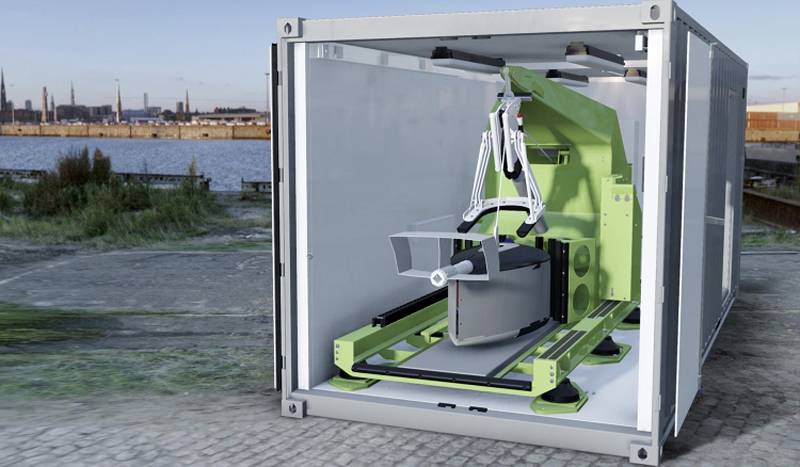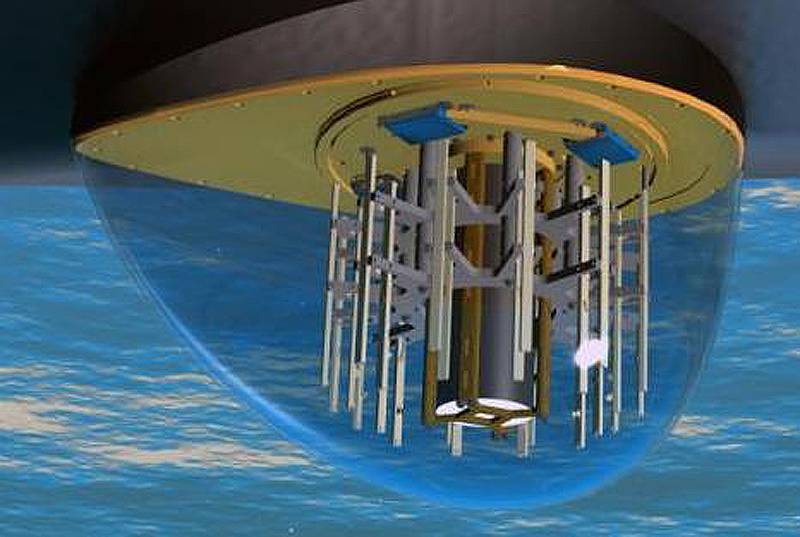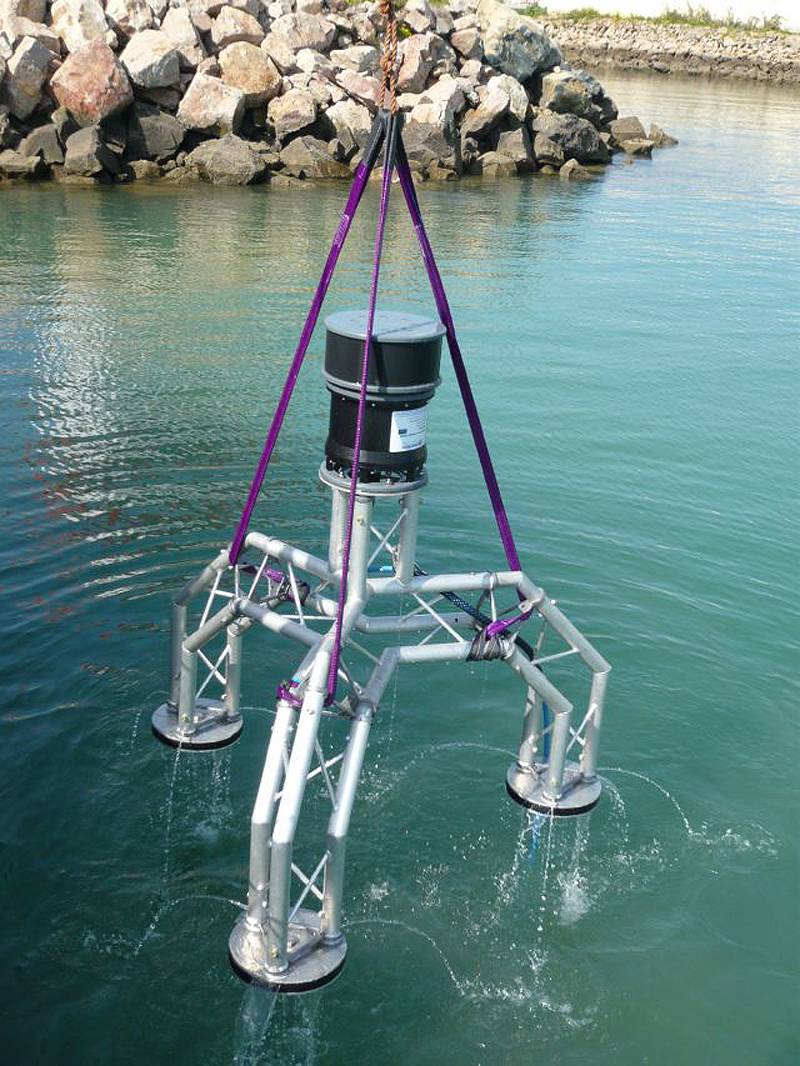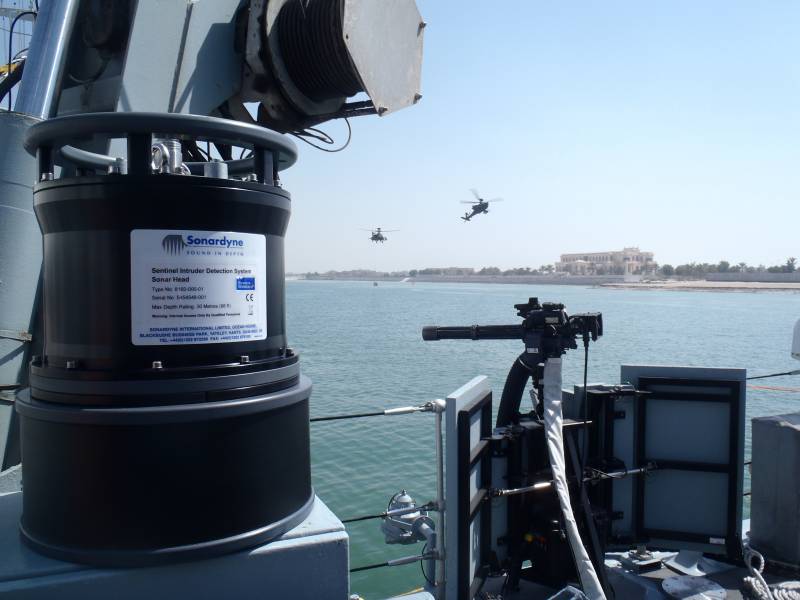A simple whistle, and how much benefit!
Sonars are used to detect both small vessels and large submarines
From submarine invasion to increasingly sophisticated methods of drug smuggling, sonar has many tasks and they are diverse. To solve these problems, fleets systems are needed for coastal patrol ships and small ships.
In recent years, a number of technological and operational trends in the development of sonars have emerged, which have been reinforced by the increased demand for these systems for small vessels.
According to Gabriel Jourdona, Head of Hydroacoustic Stations (GUS) at Thales, anti-submarine defense (PLO) has been the main task of hydroacoustic stations for decades. Moreover, the number of submarines in the world is growing, more and more countries are adopting them, and this causes concern in the military community.
“Vigorous economic activity at sea, in particular the use of ocean resources, forces states to take measures to control and protect their economic zones,” he said. - Territorial conflicts at sea arise here and there, and the invasion of a submarine into the exclusive economic zone is the main problem. This problem is compounded for some countries by the need to protect large areas. ”
These interrelated trends determine the demand for TSP systems in which sonars are a key component. “The majority of fleets and countries face the task of protecting their national sovereignty, their commercial and economic interests and countering the invasion of submarines into their national waters,” said Jourdon.
Money matters
However, the high cost of such ships PLO. such as frigates, contributed to the fact that the GUS began to install on smaller platforms and even non-military ships that were not originally intended for high-intensity PLO. This, for example, fully applies to coastal guard patrol ships (SCHP).
“The idea here is to either supplement the existing means of PLO or, as an alternative, to give the fleets of developing countries the basic capabilities of PLO. Its implementation will require efficient, proven at sea solutions with stable characteristics and real capabilities of PLO. ”
GUS should not adversely affect the ship’s navigational capabilities, he added, noting that the BlueWatcher compact case sonar, created by his company, was designed from the very beginning so as to have a minimal effect on ship maneuverability and speed.
Thales focuses on the development of sonars for SCPRs and other small vessels. At the exhibition Euronaval 2014, for example, she showed a new line of GUS. In addition to BlueWatcher, the CAPTAS-1 GAS with variable depth is also included.
According to Jourdon, BueWatcher "provides excellent detection and tracking capabilities in the noisy waters of shallow water," while he noted that this compact gas can also operate at depths at distances greater than 10 km. “It makes an invaluable contribution to the ship’s security system and at the same time helps to avoid obstacles in front of the ship.”
CAPTAS-1 "is a key means of PLO" in the company's compact radar line, providing detection at medium distances up to about 30 km. “He is making a big contribution to the containment of submarines,” he added.
Both multifunctional systems are designed to work in a variety of conditions, they are well proven and on ships with a small displacement. In some fleets, they are usually used as an additional element of PLO. Both Thales products are in good demand in promising overseas markets, including Asia, Latin America and the Middle East.
Jourdon added: “Demand has recently developed in the direction of effective sonar complexes, which can become an indispensable element of fleet operations to ensure safety in coastal and deep-sea waters. It should be compact for installation on small vessels, easy to operate, perform the required tasks at an affordable cost. ”
Changing requirements
Thomas Dale, a spokesperson for the maritime GAS department at Kongsberg Maritime Subsea, also noted the increased demand in the KCHA, where multitasking capabilities are essential. "Multitasking platforms and SIZs should be able to find not only large objects such as submarines, but also smaller objects like ultra-small submarines, floating containers or mines."
The requirements for the range of GAS for SCPH and frigates are often different. For SCPZ are required GUS with a range of 10-15 km. This is also evident for the high-speed patrol boats market, where often medium-range sonar is sufficient. Several boats "can swarm" at the same time, thereby expanding the viewing area of all vessels in the group. “You add the range of the GAS of three, four, five ships, as a result you significantly increase the coverage range through the use of several ships,” he explained.
According to Dale, the complex of tasks of the SCPC, however, forces one to seek a balance between range and capabilities. “SKPZ work more or less independently. The compromise in the market for SCPPs is that the GUS is necessary for a reasonable price, which is easy to install and which can work in several tasks - this is more important than just the range of the GUS. ”
The MFAS may be particularly useful for detecting small surface vessels. Dale noted that “it is difficult at night to detect an object similar to a rigid-hull inflatable boat, especially if you are in troubled waters. But if you have a GUS, then you can hear it in passive mode or detect the vessel or its wake sign in active mode. "
According to Dahle, the Kongsberg company focuses on coastal waters. “This segment is more than just PLO. Our products are looking for objects in the entire water column and on the seabed. They track surface ships, as well as submarines and uninhabited submarines. Our technology is designed to solve problems with reverberation (sound reflection) and work in coastal waters. ”
He drew attention to the SS2030 sonar mounted in the ship's hull and its container version of the ST2400 Variable Depth Sonar. Although they are mainly intended for coastal PLO, they are more widely used, for example, avoiding obstacles, detecting mines and tracking boats, underwater vehicles and other objects.
To this end, the Kongsberg GAS were installed on a number of small and medium-sized ships, including coast guard vessels and high-speed patrol boats. For example, the research vessel of the Chilean fleet “Cabo de Homos” last year equipped the SS2030 GAS for search and detection of submarines that had suffered an accident, which was successfully demonstrated in search and rescue exercises.
“Often, SCPZs are built without sonars, but we hope that this situation will change when the fleets better recognize the multitask capabilities of a mid-frequency sonar,” Dale said.

ST2400 container gas can be used in various tasks, including the submarineО
Divers and Swimmers Detection
The British company Sonardyne International has received all the benefits from the growing demand for diver and swimmer detection systems. For example, in July last year, she announced a new contract for the supply of an unnamed customer from Southeast Asia with Sentinel diver detection sonars that will be installed on all of them. The contract is based on the previous agreement for the supply of portable systems to one of the European fleets to protect its SQAF.
“SCPH is becoming an increasingly popular resource for fleets and the coast guard around the world in the fight against piracy, drug trafficking, terrorism and mine action,” said Sonardyne, in a statement marking the signing ceremony. - The SCPZ platform develops in its universality due to new developments in shipbuilding, allowing you to configure these vessels for various tasks through the use of commercial ready-made systems, such as, for example. Sentinel.
“Sonardyne began shipping its systems to the market for SCPZ about two years ago,” said Nick Swift, head of maritime security at the company. - We get a lot of requests. There is a certain increase in demand in this area. ”
The Sentinel system can detect, track and classify threats at a distance of 1200 meters, it can be integrated into the ship's information management system or local situational awareness systems, such as the NiDAR NiSSD long-distance surveillance system from the MARSS Group. It works in the active and passive modes of detection and classification, and can be portable or installed in the ship's hull. Option Sentinel XF (extra functionality - additional functionality) is offered for military and national security structures.
“The system can be portable or can be installed in the ship's hull using the Sonardyne special patented system,” says Swift. - We supply both configurations. Our system is inherently flexible and can be integrated into your surveillance system or your command and control system. ”
The hull-mounted version “is an excellent solution for newer and larger SQAHs,” while the portable version “can easily be deployed from any vessel and is very popular on the SADC market.”
Swift added: “Depending on how the fleets use their ships, they may not need GUS in some area of the operation. For example, if you are basing in your port, you may need complex, complex protection. And for deployment in a given area, you can take a portable system. "
The aforementioned contract with one of the Asian countries emphasized the importance of using systems to protect ships and other objects from underwater threats. "Sentinel ... provides a rapidly deployable perimeter security system to complement the protection systems for commercial harbors, ships, private yachts, important infrastructure facilities and buildings on the coast," he said.
According to Swift, the need for systems like Sentinel speaks of a bias towards asymmetric warfare. “Previously, if the ship had a gas, then it was intended for PLO, and now they began to think about smaller objects, such as divers and automatic underwater vehicles. The latter are of increasing concern. They are available in the civilian market, fairly cheap and easy to operate. And they can cause significant damage to the ship. ”
“The main use of the SAS Sentinel is to protect ships from terrorist and other attacks,” continued Swift. “It could be terrorism, a rogue state, or even a traditional conflict zone.” Another area of its application is observation. If you have an SCR, someone can send a diver or unmanned vehicle to just take pictures or watch this vessel. Gus Sentinel puts an underwater cordon around the vessel, so that no one can get close to it unnoticed. "
Ken Walker, Head of the Marine Division at Ultra Electronics, also noted the development of the market for SCPZ. Placing sonars on these vessels can be very useful, because we are talking not only about the additional capabilities of PLO, but also about the fight against drug trafficking and terrorism.
“For example, smugglers are very sophisticated,” he said. “In the past, they used more speedboats, but now they use semi-submersibles, actually using commercial submarines to transport drugs.”
Walker also drew attention to the use of sonars in the activities of fisheries, in the fight against illegal migration and a number of other areas. Weight and size and energy-consuming characteristics are also improved, and this attracts the attention of small craft operators.
According to Walker, his company also noted a growing demand for sonars for small vessels. “In the entire Western world, a radical change of structure has taken place. Budgets do not allow aircraft carriers and large destroyers, as it was during the Cold War era, so many are switching to smaller multitasking tools to protect their sovereignty, and therefore we are seeing something like a revival in the SCPR and small frigates. ”

GUS BlueWatcher detects objects in noisy coastal waters
Necessity or luxury?
Many countries do not seek to equip their anti-submarine missile defense systems with anti-submarine defense systems and, therefore, GAS on their board are not mandatory. An example is the new Canadian SARP project Harry DeWolf, the first of which, according to the head of the Canadian fleet development department, Casper Donovan, should join the fleet at the end of 2018.
“There was no need to have sonar capabilities on these vessels. The ships are designed to conduct armed surveillance of Canadian waters and support government agencies in upholding and strengthening Canada’s sovereignty when and where it is needed, in other words, to accomplish police-type tasks, ”he said.
“In carrying out these tasks, they will use other means to detect other ships, rather than GUS, such as radar and optoelectronic sensors, as well as tools such as the deck helicopter CH-148 Cyclone equipped with a set of special sensors that is being developed for Canada by Sikorsky.
According to Donovan, based on the tasks of the ships of this project, they will not need some of the high-level integrated combat systems that surface warships may require. submarines, we will not use the patrol vessel to resolve this situation. We will use one of our Halifax class frigates. ”
The Canadian fleet launched the Underwater Warfare Surte Upgrade project (a submarine warfare upgrade kit) to upgrade Halifax frigates with PLO systems. Competition terms were published in the fall of 2017, and are currently undergoing an evaluation phase.
In accordance with this project, the capabilities of the ships will be expanded through the installation of hull-based GAS towed by GAS, radio-hydro-acoustic buoys, torpedo detection systems and the integration of all these systems into the ship's BIOS. “This is a fairly large project, which will add to the overall capabilities of the ships much more modern complexes of the underwater war,” added Donovan.
He called the key technological trends of recent years - the growing level of digitization of systems and the growth of their processor capacity. This is what unites all military sensory systems. "More and more of these systems are moving to digital, which means that data can be processed much more efficiently and faster."
For GUS this is especially important, as they receive and process huge amounts of acoustic data. In the case of sonars based on digital architecture, the process is greatly simplified. "Data processing will be much better, which will increase our ability to search for submarines, mines and other underwater threats."
However, according to Donovan, large-scale development is carried out not only in the field of hydroacoustic technologies. Currently, advanced, high-tech diesel-electric submarines are in great demand. “These submarines have always been very difficult to detect. But now more and more countries are adopting diesel-electric submarines, more and more modern platforms are supplied, which are undoubtedly quieter than previous generation submarines. And if the old submarines were difficult to detect, then modern submarines are much more difficult to find. ”
In this regard, the fleets had to carefully analyze the search and detection of submarines. In the 80's and 90's, many Western fleets used towed passive GAS. But now they are increasingly switching to active options “pinging” in the water at low frequencies in order to detect modern low-noise submarines, “As part of our Underwater Warfare Suite Upgrade project, we strive to acquire towed active low-frequency sonars.”
Dale pointed to increased processing capacity. “This means that we can process several layers horizontally in one sound pulse or several pulses simultaneously. We can detect an object if it is at the level of the surface, in the water column or at the bottom. ”
He also noted the use of composite transducers in high-frequency sonars, which increases the width of the spectrum and the resolution and makes it possible to use three-coordinate processing so that “with the help of a conventional hull GAS, we can imagine the seabed in 3D, for example, for object detection or navigation tasks”.
New Technologies
According to Jourdon, in recent years acoustic technologies have noticeably advanced in several directions. He noted the use of acoustic transducers for active emitters, highly advanced signal and data processing algorithms, and progress in detection and tracking capabilities. In addition, more user-friendly and intuitive man-machine interfaces are integrated into the systems, including the use of 3D to simplify complex sonar operations.
Systems have also become more compact and easier to install, while training equipment is also not standing still, which “simplifies crew training on board the ship.”
Walker drew attention to the software. He noted, for example, Ultra's technology called the Ping Wizard, which simplifies the selection of the optimal active mode, allowing you to emit a large number of different sound pulses at the same time.
“The system actually looks down in the water and says:“ Here is your best type of signal. You should use it, ”he explained. “The system has a very high level of artificial intelligence, the work of the operator is simplified and, as a result, the level of possession of the tactical situation increases.”
According to Walker, there was an interesting change in technological trends. If in the past, the civilian sector seriously lagged behind the military world, now their positions in some areas have changed places. In sonars this can be seen in the example of the use of graphics processors from video game consoles.
“Twenty years ago, mostly military technology informed the commercial world. And now it's the other way around. Currently, video processors are ordered to increase the processing power and improve the quality of the displayed image. This is because the gaming industry, along with the telephone industry, is developing in the civilian world much faster than in the military. ”
The company Ultra Electronics supplies sonar systems for military vessels of various countries, including British destroyers of the 45 type, the Australian destroyer of the Hobart project and the Dutch frigates of the Karel Dorman project. Her new GAS S2150 will be installed when upgrading frigates such as 23. This sonar is also going to be installed on promising frigates of the 26 type; In addition, the company offers the S2150 option for the 31e frigate.
“Although this is not currently a basic requirement for the 31 type, Ultra intends to offer its Integrated Sonar Suite integrated sonar system, which includes a towed active-passive HAS and a torpedo detection and protection system in a single towed unit,” Walker said.

The Sonardyne system can be portable or installed in a ship hull.
Accelerated changes
Touching perspectives, Walker noted two “megatrends” that will have a great impact in the future. “The first is large amounts of data. This is especially important for GUS, where very large amounts of data are generated and real-time processing is necessary for target detection. The second is artificial intelligence and self-learning machines. For example, sonars will know if they have previously seen this type of submarine. ”
Dale said that any further changes in acoustic technology will naturally be limited by physical laws. "I anticipate small steps in increasing the characteristics, for example, the range of frequencies, the processing power and the number of simultaneous sound pulses."
He expects a wider use of automatic surface vehicles, especially in conjunction with ships, for example, coastal watchdog ships, “when a surface uninhabited unit is connected to the SCPR and you have the opportunity to transmit the image from the HAS via a broadband radio channel. You control the device with SCPR. I think this is a good combination and in the future it will stimulate the coastal guard patrol ships market. ”
Jourdon believes that more complex, tightly connected PLO networks will be formed with a wide range of platforms and sensors, including uninhabited systems. “Compactness is another challenge and in this area Thales is exploring the promise of new sensors. Thales is also a key player in a rapidly growing market drones. We strive to give effective ASW capabilities to new crewed and unmanned ships.”
According to Jourdon, while submarines remain the main threat, sonar requirements have changed. Along with the discovery of torpedoes, new asymmetrical threats have emerged, for example, semi-submersible or fully submersible “drug squads” used by smugglers. Speedboats are also among the priority objectives, especially given their use for terrorist purposes.
"Threats that must be addressed affect the capabilities and characteristics of hydroacoustic stations, which must be effective in active and passive modes and in almost all environmental conditions, including shallow water and great depths."
Materials used: Alex Alexeev
www.shephardmedia.com
www.thalesgroup.com
www.km.kongsberg.com
www.sonardyne.com
www.ultra-electronics.com
www.wikipedia.org
en.wikipedia.org

Information